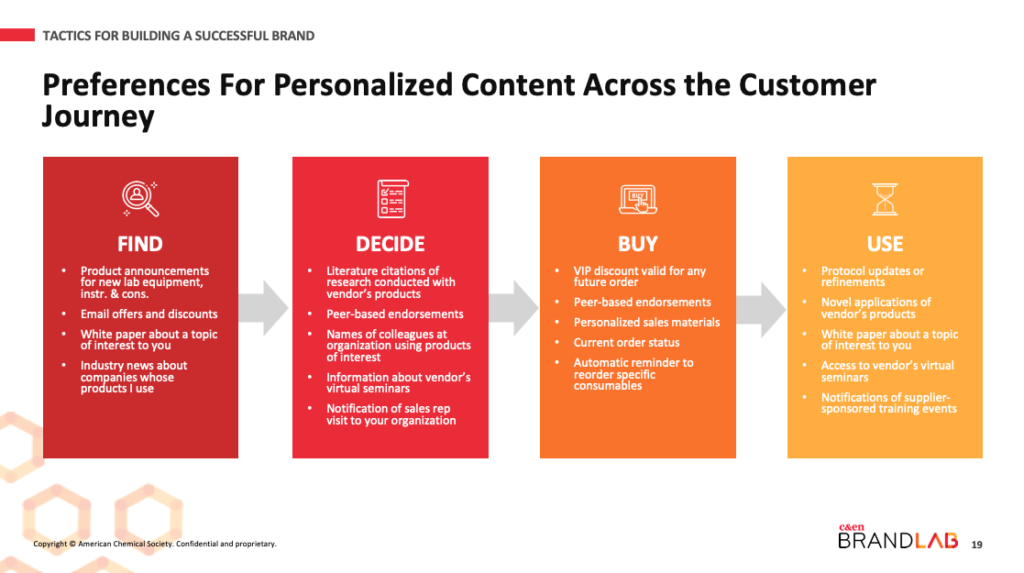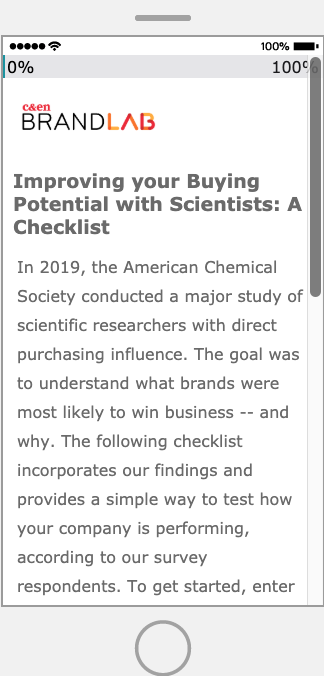How Brand Perception Influences Buyers in the Chemical and Life Sciences Space

Do you know what drives buyers to purchase your products? What influences buying teams to consider your brand in the first place?
Stephanie Holland, director of global advertising sales at C&EN Media Group, answered these questions and more in a webinar presenting the findings of C&EN BrandLab’s research on the buying preferences of scientific researchers.
Our data determines how buying teams actually think and feel about some of the largest brands in our industry.
This research includes the responses of 779 scientists – the majority of whom have direct purchasing influence – and together represent more than $150 million in purchasing power.
Respondents specifically examined 23 different brands, enabling us to hone in on the drivers that explain how successful brands are winning business in the specialty chemical and instrumentation space.
The survey findings identified five key drivers above all others that enable brands to capture buyer attention, gain both trust and recognition as a leading organization in our space, and ultimately, drive purchasing behavior.
These five key pillars are:

1. Organizational Visibility: Does your brand have a positive presence at industry events and conferences? Our study found that brands that are active in the market, specifically through speaking engagements or exhibitions, are better able to get those critical conversations with buyers.

2. Product Performance: Buyers want partners that they can trust, not just a sales pitch that falls flat in practice. Does your product maintain consistent performance for customers?

3. Customer Experience: Are you thinking about customer service, both before and after the sale? Buyers want to work with brands that make the time and effort to serve their needs well beyond a purchase.

4. Product Innovation: Innovation gives buyers confidence that you can help handle not just their current needs, but also help solve their future problems. As noted in our webinar, innovation goes beyond product applications, too. Buyers pay attention to everything from the way you innovate in your collaborations to your marketing campaigns.

5. Corporate Citizenship: Do you maintain sustainable manufacturing? Buyers want to see evidence of social responsibility from those they choose to partner with, and proof that their values are reflected in any partnership.
Applying the Five Drivers
When pitching buyers in a crowded marketplace (especially with large buying teams), successful brands break through when they create clear value and prove consistency to their customers. According to a 2019 study from Demand Gen, the value of detailed content and resources continues to rise – the majority (73%) of respondents agree that they are relying on more sources to research and evaluate purchases. However, though we know buyers seek helpful, educational content, Content Marketing Institute recently found that only 66% of content marketing programs prioritize their audience’s informational needs over their organization’s sales/promotional message.
This is where smart digital content marketing can come into play, to help bridge the gap between buyer needs and telling your own story.
To help webinar attendees think about these tactics, Stephanie was joined by Bill Kelly, President of BioInformatics, who delivered a presentation covering the best tactics for building a successful brand among scientific audiences. Bill noted that “customers have very different needs at each stage of the buying cycle, and this results in different content messaging that can be developed by marketers,” as illustrated by a portion of his presentation below.

The smart deployment of tactics across social, influencer, and publisher channels are critical to building a successful digital marketing experience.
Wondering how to get started in evaluating your own brand’s buyer outreach efforts? First, catch up on the overview of the survey findings by watching the recap of the webinar, including Stephanie and Bill’s presentations, as well as answers to attendee questions such as:
How have brands best displayed themselves as innovative to scientists?
What is the best way to get scientists as brand ambassadors or participants in content storytelling?
Which tactics will help brands in the life sciences space attract a younger audience or serve Millennial buyers?
What are the most common mistakes brands make in trying to reach scientists?
What are great examples of event marketing in brand building efforts that science brands can draw inspiration from?

Next, take C&EN BrandLab’s Brand Health Checklist to help you test how your own company is performing among the same key drivers we identified in our study.
In five minutes, you’ll have a sense of which areas your organization is already succeeding in, and which areas need more attention.
It’s a great way to get started down the path of understanding and better serving your customers and buyers.
If you have any questions about your results, or to find out more about C&EN BrandLab’s research findings, please get in touch at [email protected].







